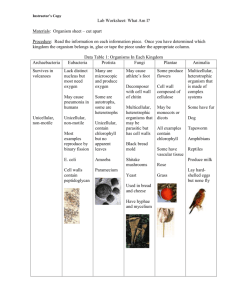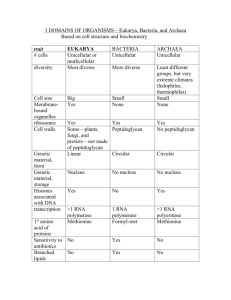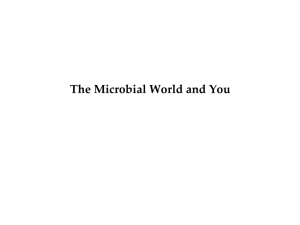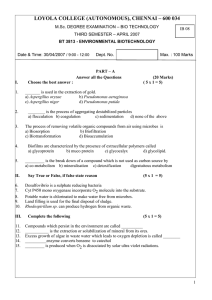BIOL 260-General Microbiology Instructor: Jennifer Ward
advertisement
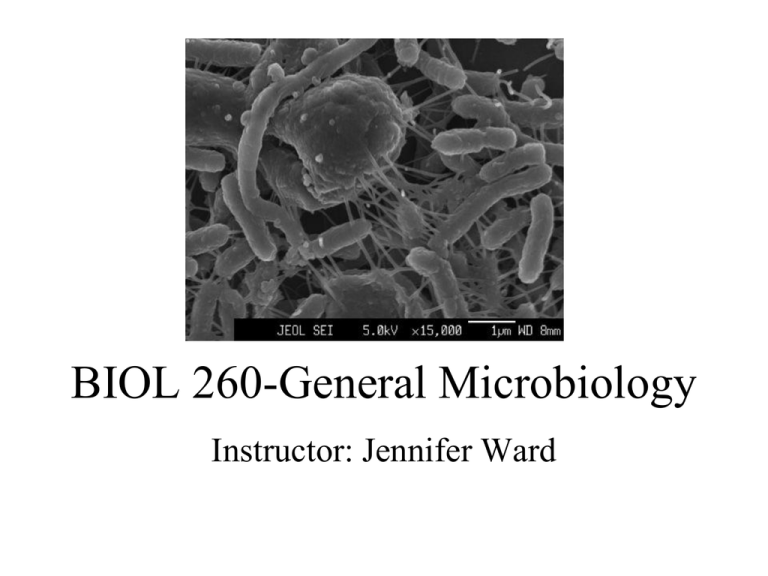
BIOL 260-General Microbiology Instructor: Jennifer Ward What is microbiology? • The scientific discipline which studies microbes or microorganisms – The biology of microbes – The interaction of microbes with other microbes, the environment, and humans Question to think about (advance notice = this will be a 2 point extra credit question on the final exam): why is microbiology important? **Types of microbes** • • • • • • Algae Fungi Protozoa Bacteria Archaea Viruses Know the basic characteristics of each type of microbe, as outlined in slides 8-13. Note that since we have covered bacteria and viruses in more depth you will be expected to know more about these types of organisms than what is covered in these slides. Kingdoms give way to Domains 1. Kingdom was formerly the highest level of classification 2. Initially all organisms were separated into 2 Kingdoms: Plantae and Animalia 3. Discovery of microscope > realization of greater complexity in our world > new levels of classification added Kingdoms give way to Domains • The 5 Kingdom system: – Monera, Protista, Fungi, Plantae, Animalia • The 6 Kingdom system: – Split Monera to form Archaebacteria and Eubacteria • The 3 Domain system – Archaea • Kingdom Archaebacteria – Bacteria • Kingdom Eubacteria – Eukarya (or Eucarya) • Kingdoms Protista, Fungi, Plantae & Animalia • Next revision = ? Three Domain System Know the 3 domains; know which of the eukaryotes fall under the study of microbiology; know the basic differences between eukaryotic and prokaryotic cells Types of Microbes: Algae • • • • • • Domain: Eukarya (“true nucleus”) Kingdom Protista Unicellular and multicellular species Photosynthetic Rigid cell walls (do NOT contain peptidoglycan) Many are motile These organisms have an interesting life cycle but I will NOT ask you about it on the exam so don’t worry about memorizing this diagram! Types of Microbes: Fungi • • • Domain: Eukarya (“true nucleus”) Kingdom: Fungi Unicellular and multicellular species – • • • Molds, yeasts & higher fungi Chemoheterotrophs; many are saprophytic Rigid cell walls (do NOT contain peptidoglycan) Sexual and asexual life stages Again, cool life cycle, but it won’t be on your exam Types of Microbes: Protozoa • • • • • • • Domain: Eukarya Kingdom: Protista (for now) Unicellular species Chemoheterotrophs No cell wall Sexual and asexual life stages Most are motile (cilia, flagella, pseudopodia) Int. hosts Toxoplasma gondii trophozoites Things I might ask you about T. gondii: 1. What is the definitive host? 2. Name one intermediate host. 3. What are 2 ways that other species (accidental hosts, including people) become infected? Definitive host Life cycle of Toxoplasma gondii Types of Microbes: Viruses, viroiods & prions • • Non-living infectious agents All living organisms have viruses • Viruses: DNA or RNA + protein coat – • Viroids: DNA or RNA – • Uses host cell mechanisms for replication of DNA or RNA and protein transcription Use host cell mechanisms for replication Prions: protein – – – Abnormally folded protein Induces conformational change in native proteins to the abnormal form Diseases currently known/believed to be caused by prions: • • • • • Bovine spongiform encephalopathy (aka mad cow disease) Kruezfield-Jacobs disease Kuru Scrapie Chronic wasting disease Types of Microbes: Archaea • • • • • • • • • • Domain: Archaea Kingdom: Archaebacteria Prokaryotic cells (“Prenucleus”) Unicellular species No membrane-bound organelles Genetic material localized to nucleoid Cell wall (no peptidoglycan) Most divide by binary fission Some are motile (flagella) Adapted to extreme environments Types of Microbes: Bacteria • • • • • • • • • • • Domain: Bacteria Kingdom: Eubacteria Prokaryotic cells (“Prenucleus”) All are unicellular species No membrane-bound organelles Genetic material localized to nucleoid Rigid cell wall – contains peptidoglycan Most divide by binary fission Some are motile (flagella) In nearly all environments Only a small percentage of the species we know are pathogenic The Binomial System of Nomenclature • Living organisms: classified (and reclassified) according to Binomial System – – – – – – Know what the binomial system is, which part of the name refers to genus and which refers to species, which is the broader category and which is more specific, and what the convention is for writing the proper names of organisms. Note that the convention is that we either italicize or underline the formal latin names when we identify an organism to species – when writing free hand these should be underlined, since we can’t italicize in free hand. Escherichia coli [“Escherichia” = genus, “coli” = species] Staphylococcus aureus Helicobacter pylori Toxoplasma gondii Histoplasma capsulatum Mycoplasma hemofelis (Hemobartonella felis) Classifications are based on our current best understanding of phylogeny and this understanding evolves with new knowledge

